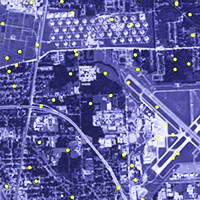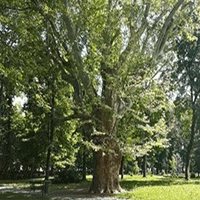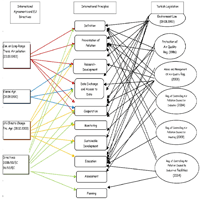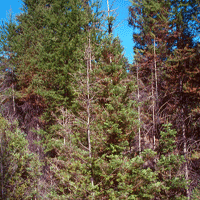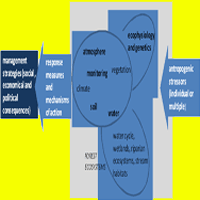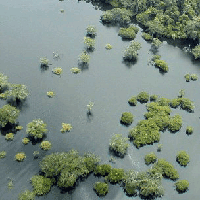Understanding an urban forest’s structure, function, and value can promote management decisions that will improve environmental quality and human health. Using i-Tree Eco software and its sampling and data collection protocol, an assessment of the baseline condition, ecological function, and value of the urban forests in Scotlandville (Louisiana, USA) was conducted during 2014. A stratified (by land use type) random sample plot map of the town was generated. Data from 170 field plots located throughout Scotlandville were collected, including tree species, diameter at breast height, total tree height, height to live top, height to crown base, crown width, crown dieback, crown light exposure, percent impervious surface under the tree, and direction and distance to building. Data were then entered into i-Tree Eco v5.0 and analyzed. Modeling results indicated that there are a total of 31 species and an estimated 239.000 trees in Scotlandville with a tree canopy cover of 23.7 percent; the three most common species are Black willow (Salix nigra), Water oak (Quercus nigra), and American elm (Ulmus americana); the overall tree density is 77 trees per hectare and trees with diameters of more than 15 cm (6 inches) constitute 56.5% of the population. The model estimated that annually, the urban forests in Scotlandville remove 96 tons of air pollutants; gross sequestration is about 3.880 tons of carbon and net carbon sequestration is about 3.650 tons. Each year, trees in Scotlandville are estimated to store 88.700 tons of carbon, produce 9.720 tons of oxygen, reduce runoff by 121.200 m3, reduce energy-related costs by $324.000 USD, and provide an additional $52.595 in value by reducing the amount of carbon released by power plants (a reduction of 739 tons of carbon emissions). The structural value for Scotlandville community forest is estimated at $185 million and the annual ecological functional value is estimated at 9 million USD. These results provide baseline information for management recommendations to maximize the ecological benefits provided by trees.
Keywords
, , , , , ,
Citation
Ning ZH, Chambers R, Abdollahi K (2016). Modeling air pollutant removal, carbon storage, and CO2 sequestration potential of urban forests in Scotlandville, Louisiana, USA. iForest 9: 860-867. - doi: 10.3832/ifor1845-009
Academic Editor
Elena Paoletti
Paper history
Received: Aug 31, 2015
Accepted: Jul 13, 2016
First online: Sep 22, 2016
Publication Date: Dec 14, 2016
Publication Time: 2.37 months
© SISEF - The Italian Society of Silviculture and Forest Ecology 2016
Open Access
This article is distributed under the terms of the Creative Commons Attribution-Non Commercial 4.0 International (https://creativecommons.org/licenses/by-nc/4.0/), which permits unrestricted use, distribution, and reproduction in any medium, provided you give appropriate credit to the original author(s) and the source, provide a link to the Creative Commons license, and indicate if changes were made.

Breakdown by View Type
(Waiting for server response...)
Article Usage
Total Article Views: 55241
(from publication date up to now)
Breakdown by View Type
HTML Page Views: 44432
Abstract Page Views: 4046
PDF Downloads: 5133
Citation/Reference Downloads: 85
XML Downloads: 1545
Web Metrics
Days since publication: 3372
Overall contacts: 55241
Avg. contacts per week: 114.68
Article Citations
Article citations are based on data periodically collected from the Clarivate Web of Science web site
(last update: Mar 2025)
Total number of cites (since 2016): 13
Average cites per year: 1.30
Publication Metrics
by Dimensions ©
Articles citing this article
List of the papers citing this article based on CrossRef Cited-by.
(1)
Abd-Elrahman AH, Thornhill ME, Andreu MG, Escobedo F (2010)A community-based urban forest inventory using online mapping services and consumer-grade digital images. International Journal of Applied Earth Observation and Geoinformation 12 (4): 249-260.
CrossRef |
Gscholar
(2)
Abdollahi KK, Ning ZH, Appeaning A (2000)Global climate change and the urban forest. GCRCC and Franklin Press, Baton Rouge, LA, USA, pp. 77.
Gscholar
(3)
Baldocchi DD, Hicks BB, Camara P (1987)A canopy stomatal resistance model for gaseous deposition to vegetated surfaces. Atmospheric Environment 21: 91-101.
CrossRef |
Gscholar
(4)
Baldocchi DD (1988)A multi-layer model for estimating sulfur dioxide deposition to a deciduous oak forest canopy. Atmospheric Environment 22: 869-884.
CrossRef |
Gscholar
(5)
Baró F, Chaparro L, Gomez-Baggethun E, Langemeyer J, Nowak DJ, Terradas T (2014)Contribution of ecosystem services to air quality and climate change mitigation policies: the case of urban forests in Barcelona, Spain. AMBIO 43: 466-479.
CrossRef |
Gscholar
(6)
Beckett KP, Freer-Smith PH, Taylor G (1998)Urban woodlands: their role in reducing the effects of particulate pollution. Environmental Pollution 99: 347-360.
CrossRef |
Gscholar
(7)
Bidwell RGS, Fraser DE (1972)Carbon monoxide uptake and metabolism by leaves. Canadian Journal of Botany 50: 1435-1439.
CrossRef |
Gscholar
(8)
Bolund P, Hunhammar S (1999)Ecosystem services in urban areas. Ecological Economics 29 (2): 293-301.
CrossRef |
Gscholar
(9)
Broecker WS (1970)Man’s oxygen reserve. Science 168: 1537-1538.
CrossRef |
Gscholar
(10)
Chaparro L, Terradas J (2009)Ecological services of urban forest in Barcelona. Center for Ecological Research and Forestry Applications, Autonomous University of Barcelona, Bellaterra, Spain, pp. 96. -
Online |
Gscholar
(11)
City of Toronto (2011)Every tree counts: a portrait of Toronto’s urban forest. City of Toronto Parks, Forestry and Recreation, Urban Forestry, Toronto, Canada, pp. 63.
Gscholar
(12)
Clark JR, Matheny NP, Cross G, Wake V (1997)A model of urban forest sustainability. Journal of Arboriculture 23: 17-30.
Online |
Gscholar
(13)
Davidson K, Hallberg A, McCubbin D, Hubbell B (2007)Analysis of PM
2.5 using the environmental benefits mapping and analysis program (BenMAP). Journal of Toxicology and Environmental Health 70 (3): 332-346.
CrossRef |
Gscholar
(14)
Dwyer JF, McPherson EG, Schroeder HW, Rowntree RA (1992)Assessing the benefits and costs of the urban forest. Journal of Arboriculture 18: 227-227.
Gscholar
(15)
Dwyer JF, Nowak DJ, Noble MH (2003)Sustaining urban forests. Journal of Arboriculture 29 (1): 49-55.
Gscholar
(16)
Fankhauser S (1994)The social costs of greenhouse gas emissions: an expected value approach. The Energy Journal 15: 157-184.
CrossRef |
Gscholar
(17)
Gooding RF, Ingram JB, Urban JR, Bloch LB, Steigerwaldt WM, Harris RW, Allen EN (2000)Guide for plant appraisal (9th edn). Council of Tree and Landscape Appraisers, International Society of Arboriculture, Champaign, IL, USA, pp. 143.
Gscholar
(18)
Gower ST, Kucharik CK, Norman JM (1999)Direct and indirect estimation of leaf area index, fAPAR, and net primary production of terrestrial ecosystems. Remote Sensing of Environment 70 (1): 29-51.
CrossRef |
Gscholar
(19)
Haase D, Frantzeskaki N, Elmqvist T (2014a)Ecosystem services in urban landscapes: practical applications and governance implications. AMBIO 43 (4): 407-412.
CrossRef |
Gscholar
(20)
Haase D, Larondelle N, Andersson E (2014b)A quantitative review of urban ecosystem service assessments: concepts, models, and implementation. AMBIO 43 (4): 413-433.
CrossRef |
Gscholar
(21)
Hirabayashi S, Kroll C, Nowak D (2011)Component-based development and sensitivity analyses of an air pollutant dry deposition model. Environmental Modeling and Software 26 (6): 804-816.
CrossRef |
Gscholar
(22)
Hirabayashi S (2013)i-Tree Eco precipitation interception model descriptions. USDA Forest Service, USA, pp. 19.
Online |
Gscholar
(23)
Konijendijk CC (1999)Urban forestry: comparative analysis of policies and concepts in Europe. Contemporary Urban Forest Policy-Making in Selected Cities and Countries of Europe, EFI Working Paper 20, European Forestry Institute, Joensuu, Finland, pp. 266.
Gscholar
(24)
Kuchelmeister G (1998)Urban forestry in the Asia-Pacific region - status and prospects. Asia-Pacific forestry sector outlook study. Working Paper APFSOS/SP/44, Forestry Policy and Planning Division, FAO, Rome, Italy, pp. 70.
Online |
Gscholar
(25)
Lovett GM (1994)Atmospheric deposition of nutrients and pollutants in North America: an ecological perspective. Ecological Applications 4: 629-650.
CrossRef |
Gscholar
(26)
Maco SE, McPherson EG (2003)A practical approach to assessing structure, function, and value of street tree populations in small communities. Journal of Arboriculture 29: 84-97.
Online |
Gscholar
(27)
Marshall JD, Waring RH (1986)Comparison of methods of estimating leaf-area index in old-growth Douglas fir. Ecology 67 (4): 975-979.
CrossRef |
Gscholar
(28)
Martin NA (2013)A 100% tree inventory using i-Tree Eco protocol: a case study at Auburn University, Alabama. Journal of Arboriculture and Urban Forestry 39 (2): 56-61.
Online |
Gscholar
(29)
McPherson EG, Simpson JR (1999)Carbon dioxide reduction through urban forestry: guidelines for professional and volunteer tree planters. General Technical Report PSW-171, Pacific Southwest Research Station, USDA Forest Service, Albany, CA, USA, pp. 237.
Online |
Gscholar
(30)
McPherson EG (2006)Urban forestry in North America. Renewable Resource Journal 24 (3): 8-12.
Online |
Gscholar
(31)
McPherson EG (2010a)Tools for valuing tree and park services. Western Arborist 36: 58-63.
Online |
Gscholar
(32)
McPherson EG (2010b)Selecting reference cities for i-Tree Streets. Arboriculture and Urban Forestry 36: 230-240.
Online |
Gscholar
(33)
Meza HMB (1992)Current situation of the urban forest in Mexico City. Journal of Arboriculture 18: 33-36.
Online |
Gscholar
(34)
Murray FJ, Marsh L, Bradford PA (1994)New York State energy plan. Vol II, Issues Report. New York State Energy Office, Albany, NY, USA, pp. 210.
Gscholar
(35)
Neely D (1988)Valuation of landscape trees, shrubs, and other plants. Council of Tree and Landscape Appraisers, International Society of Arboriculture, Champaign, IL, USA, pp. 50.
Online |
Gscholar
(36)
Nowak DJ (1994)Atmospheric carbon dioxide reduction by Chicago’s urban forest. Chicago’s urban forest ecosystem: results of the Chicago Urban Forest Climate Project. General Technical Report NE-186, USDA Forest Service, Northeastern Forest, Experiment Station, Radnor, PA, USA, pp. 83-94.
Online |
Gscholar
(37)
Nowak DJ, Crane DE (2000)The Urban Forest Effects (UFORE) Model: quantifying urban forest structure and functions. In: Proceedings of the International Union of Forestry Research Organizations (IUFRO) Conference “Integrated Tools for Natural Resources Inventories in the 21st Century” (Hansen M, Burk T eds). St. Paul, MN, USA, pp. 714-720.
Online |
Gscholar
(38)
Nowak DJ, Noble MH, Sisinni SM, Dwyer JF (2001)People and trees: assessing the U.S. urban forest resource. Journal of Forestry 99: 37-42.
Online |
Gscholar
(39)
Nowak DJ, Crane DE (2002)Carbon storage and sequestration by urban trees in the USA. Environmental Pollution 116: 381-389.
CrossRef |
Gscholar
(40)
Nowak DJ, Crane DE, Dwyer JF (2002)Compensatory value of urban trees in the United States. Journal of Arboriculture 28 (4): 194-199.
Online |
Gscholar
(41)
Nowak DJ, Walton JT (2005)Projected urban growth (2000-2050) and its estimated impact on the US forest resource. Journal of Forestry 103 (8): 383-389.
Online |
Gscholar
(42)
Nowak DJ, Crane DE, Stevens JC (2006)Air pollution removal by urban trees and shrubs in the United States. Urban Forestry and Urban Greening 4 (3): 115-123.
CrossRef |
Gscholar
(43)
Nowak DJ, Dwyer JF (2007)Understanding the benefits and costs of urban forest ecosystems. In: “Urban and Community Forestry in the Northeast”. Springer, Netherlands. pp. 25-46.
CrossRef |
Gscholar
(44)
Nowak DJ, Hoehn R, Crane DE (2007)Oxygen production by urban trees in the United States. Arboriculture and Urban Forestry 33 (3): 220-226.
Online |
Gscholar
(45)
Nowak DJ, Crane DE, Stevens JC, Hoehn RE, Walton JT, Bond J (2008a)A ground-based method of assessing urban forest structure and ecosystem services. Arboriculture and Urban Forestry 34: 347-358.
Online |
Gscholar
(46)
Nowak DJ, Walton JT, Stevens JC, Crane DE, Hoehn RE (2008b)Effect of plot and sample size on timing and precision of urban forest assessments. Arboriculture and Urban Forestry 34 (6): 386-390.
Online |
Gscholar
(47)
Nowak DJ, Hoehn RE, Crane DE, Stevens JC, Fisher CL (2010a)Assessing urban forest effects and values, Chicago’s urban forest. Resource Bulletin NRS-37, USDA Forest Service, Northern Research Station, Newtown Square, PA, USA, pp. 27.
Online |
Gscholar
(48)
Nowak DJ, Stein SM, Randler PB, Greenfield EJ, Comas SJ, Carr MA, Alig RJ (2010b)Sustaining America’s urban trees and forests: forests on the edge report. Resource Bulletin NRS-36, USDA Forest Service, Northern Research Station, Newtown Square, PA, USA, pp. 28.
Online |
Gscholar
(49)
Nowak DJ, Greenfield EJ, Hoehn RE, Lapoint E (2013)Carbon storage and sequestration by trees in urban and community areas of the United States. Environmental Pollution 178: 229-236.
CrossRef |
Gscholar
(50)
Nowak DJ, Hirabayashi S, Bodine A, Greenfield E (2014)Tree and forest effects on air quality and human health in the United States. Environmental Pollution 193: 119-129.
CrossRef |
Gscholar
(51)
Pandit R, Laband DN (2010)Energy savings from tree shade. Ecological Economics 69 (6): 1324-1329.
CrossRef |
Gscholar
(52)
Paoletti E (2009)Ozone and urban forests in Italy. Environmental Pollution 157 (5): 1506-1512.
CrossRef |
Gscholar
(53)
Paoletti Bardelli ET, Giovannini B, Pecchioli L (2011)Air quality impact of an urban park over time. Urban Environmental Pollution 2010. Procedia Environmental Sciences 4 (2011): 10-16.
CrossRef |
Gscholar
(54)
Reich PB, Walters MB, Ellsworth DS (1992)Leaf life-span in relation to leaf, plant, and stand characteristics among diverse ecosystems. Ecological Monographs 62 (3): 365-392.
CrossRef |
Gscholar
(55)
Rogers K, Sacre K, Goodenough J, Doick K (2015)Valuing London’s urban forest. Results of the London i-Tree Eco Project. Treeconomics, London, UK, pp. 84.
Online |
Gscholar
(56)
Rowntree RA, Nowak DJ (1991)Quantifying the role of urban forests in removing atmospheric carbon dioxide. Journal of Arboriculture 17 (10): 269-275.
Online |
Gscholar
(57)
Saunders SM, Dade E, Van Niel K (2011)An Urban Forest Effects (UFORE) model study of the integrated effects of vegetation on local air pollution in the western suburbs of Perth, WA. In: Proceedings of the “19th International Congress on Modelling and Simulation”. Perth (Australia) 12-16 Dec 2011, pp. 1824-1830.
Online |
Gscholar
(58)
Smith PD, Merritt M, Nowak D, Hitchcock D (2005)Houston’s regional forest - structure, functions, values. The Texas Forest Service, Texas A&M University System, Texas, USA, pp. 23.
Gscholar
(59)
Tyrväinen L, Väänänen H (1998)The economic value of urban forest amenities: an application of the contingent valuation method. Landscape and Urban Planning 43 (1): 105-118.
CrossRef |
Gscholar
(60)
US Conference of Mayors (2007)Protecting and developing the urban tree canopy - a 135 city survey. US Conference of Mayors, Washington, DC, USA, pp. 34.
Gscholar
(61)
USDA (2015)I-Tree Eco Manual. Northern Research Station, USDA Forest Service, Website.
Online |
Gscholar
(62)
West JM, Julius SH, Kareiva P, Enquist C, Lawler JJ, Petersen B, Shaw MR (2009)US natural resources and climate change: concepts and approaches for management adaptation. Environmental Management 44 (6): 1001-1021.
CrossRef |
Gscholar
(63)
Wolf K (2009)Strip malls, city trees, and community values. Arboriculture and Urban Forestry 35 (1): 33-40.
Online |
Gscholar
(64)
Yang J, McBride J, Zhou J, Sun Z (2005)The urban forest in Beijing and its role in air pollution reduction. Urban Forestry and Urban Greening 3: 65-78.
CrossRef |
Gscholar
(65)
Yang J, Chang Y, Yan P (2015)Ranking the suitability of common urban tree species for controlling PM
2.5 pollution. Atmospheric Pollution Research (6): 267-277.
CrossRef |
Gscholar
